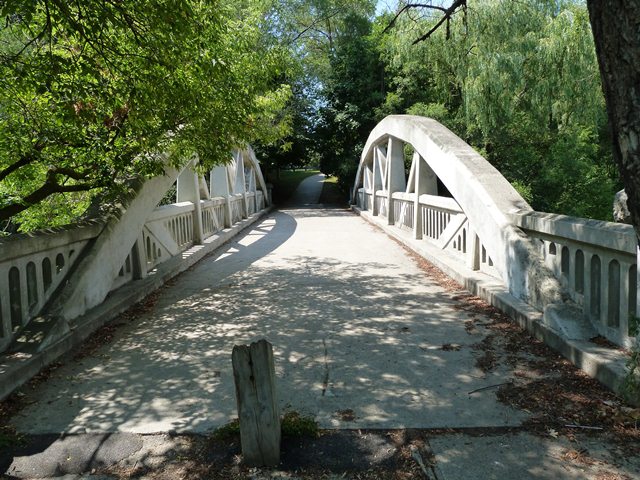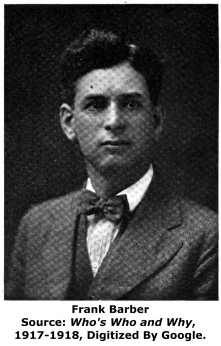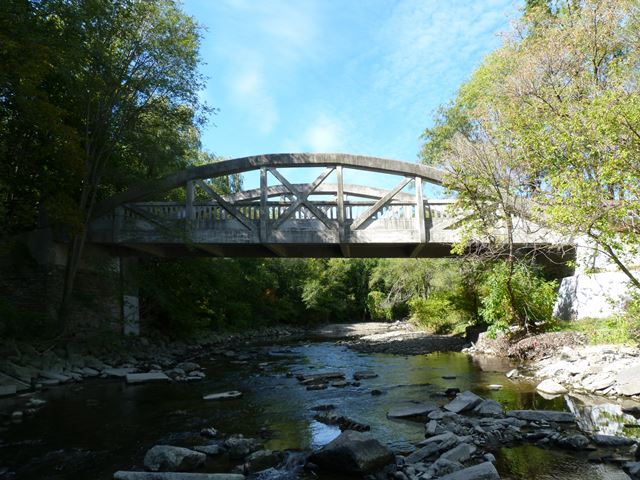We Recommend:
Bach Steel - Experts at historic truss bridge restoration.
BridgeHunter.com Phase 1 is released to the public! - Visit Now
Middle Road Bridge
Sherway Drive Bridge

Primary Photographer(s): Nathan Holth
Bridge Documented: July 23, 2012 and September 27, 2015
Mississauga and Toronto: Peel Region, Ontario and Toronto City, Ontario: Canada
1909 By Builder/Contractor: O.L. Hicks of Humber Bay, Ontario and Engineer/Design: Frank Barber of Toronto, Ontario
Not Available or Not Applicable
Not Available
85.6 Feet (26.1 Meters)
14 Feet (4.27 Meters)
1 Main Span(s)
Not Applicable

View Information About HSR Ratings
Bridge Documentation
View Historical Biographies of Frank Barber
View Historical Articles About This Bridge
This is one of the oldest and most unique concrete bridges in Canada. The bridge defies classification. It has been described as a concrete truss, and also as a concrete arch. If defined as an arch it must be noted that it is a spandrel braced arch, meaning it is an arch bridge that has diagonal members. In favor of the truss description is that fact that the top chord / arch rib is not perfectly curved, but instead has a polygonal appearance to it, where a curve is generated by a series of straight beams at different angles. Also in favor of the truss description are the presence of diagonal members. In favor of the concrete arch description is the fact that there is no defined end post as in a truss, rather the top chord / arch rib maintains a constant arc from abutment to abutment. Also in favor of the concrete arch theory is the exceeding rarity of concrete truss bridges worldwide. Finally, it is possible that, like bowstring truss bridges of the 1870s, that the bridge incorporates a combination of arch and truss thinking into its design.
For clarity, HistoricBridges.org currently describes the bridge as an arch. In particular, this helps clarify the bridge's place in history. Ignoring the diagonal members, this bridge is essentially a "rainbow arch" type of bridge, often called a concrete bowstring bridge in Canada. The bridge was built in 1909. Another rainbow arch built in this year is the Benson Street Bridge in Ohio. Both of these bridges were built before James Barney Marsh patented his design for what is called a Marsh arch, a type of rainbow arch. The Marsh arch bridges are generally considered to be the first bridges that made the rainbow arch type of bridge popular for a while. However, both the Benson Street and Middle Road bridges, predating his patent, certainly shows that James Marsh was not the first person to design such a bridge. As such, the Middle Road Bridge is nationally significant as a prototypical example of a rainbow arch bridge, a bridge type that enjoyed popularity in Ontario in the 1920s and 1930s.
Information and Findings From Canada's Historic PlacesDescription of Historic Place The Middle Road Bridge is located at the eastern terminus of Sherway Drive and spans the Etobicoke Creek which acts as a boundary between the City of Mississauga and the City of Toronto. Heritage Value The heritage value of the Middle Road Bridge lies in its architectural and historical significance, and in its contextual value as an important community landmark. Character-Defining Elements Key character-defining elements that embody the heritage value of the bridge as an early example of reinforced concrete truss or tied arch bridge construction include its: Heritage Designation and Type: Municipal |
This bridge is tagged with the following special condition(s): Unorganized Photos
![]()
Photo Galleries and Videos: Middle Road Bridge
2012 Bridge Photo-Documentation
Original / Full Size PhotosA collection of overview and detail photos. This gallery offers photos in the highest available resolution and file size in a touch-friendly popup viewer.
Alternatively, Browse Without Using Viewer
![]()
2012 Bridge Photo-Documentation
Mobile Optimized PhotosA collection of overview and detail photos. This gallery features data-friendly, fast-loading photos in a touch-friendly popup viewer.
Alternatively, Browse Without Using Viewer
![]()
2015 Additional Unorganized Photos
Original / Full Size PhotosA supplemental collection of photos that are from additional visit(s) to the bridge and have not been organized or captioned. This gallery offers photos in the highest available resolution and file size in a touch-friendly popup viewer.
Alternatively, Browse Without Using Viewer
![]()
2015 Additional Unorganized Photos
Mobile Optimized PhotosA supplemental collection of photos that are from additional visit(s) to the bridge and have not been organized or captioned. This gallery features data-friendly, fast-loading photos in a touch-friendly popup viewer.
Alternatively, Browse Without Using Viewer
![]()
Maps and Links: Middle Road Bridge
Coordinates (Latitude, Longitude):
Search For Additional Bridge Listings:
Additional Maps:
Google Streetview (If Available)
GeoHack (Additional Links and Coordinates)
Apple Maps (Via DuckDuckGo Search)
Apple Maps (Apple devices only)
Android: Open Location In Your Map or GPS App
Flickr Gallery (Find Nearby Photos)
Wikimedia Commons (Find Nearby Photos)
Directions Via Sygic For Android
Directions Via Sygic For iOS and Android Dolphin Browser




